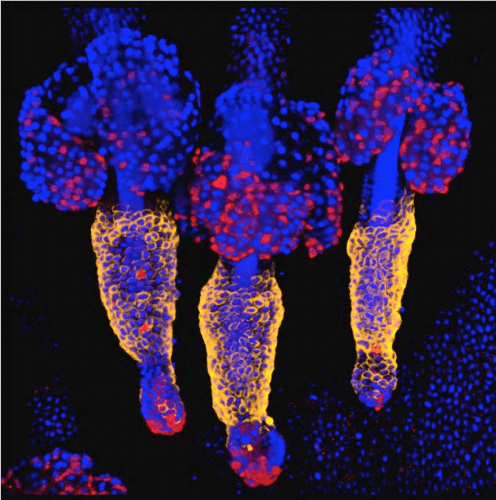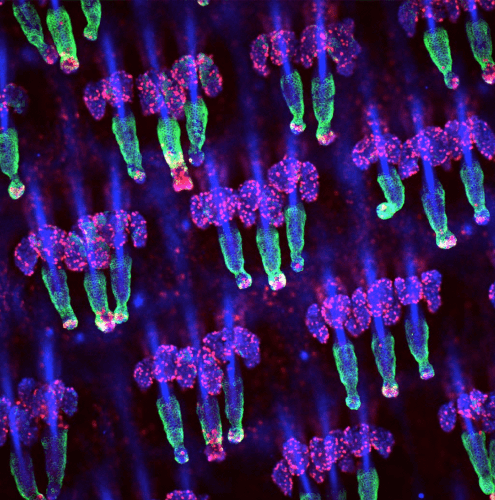A study conducted at the Faculty of Biology at the Technion raises new findings regarding the role of the caspase-3 protein in cell division, in the development of cancer and in determining the size of organs in our body. The study was published in the journal Molecular Cell, which also chose to display it on the cover of the issue


A study conducted at the Faculty of Biology at the Technion raises new findings regarding the role of the caspase-3 protein in cell division, in the development of cancer and in determining the size of organs in our body. The study was published in the journal Molecular Cell, which also chose to display it on the cover of the issue.
The size of an organ is derived from many factors including the size of each individual cell, the processes of division, differentiation and death of the cells and of course their number. However, the molecular "master plan" that controls these processes is still not completely clear. Hence the importance of the current research, which was conducted under the guidance of Associate Professor Yaron Fuchs and led by Dr. Yahav Josephson.
Technion researchers have uncovered a previously unknown molecular mechanism that controls the size of the sebaceous gland in the skin. The skin is the largest organ in the human body. The weight of the skin of an adult is about 9 kg and its total area is about 2 square meters. The skin consists of the epidermis (the outer layer) and the dermis (which is underneath). The sebaceous glands located in the epidermis produce and secrete a fatty substance (sebum) that protects the skin and the hairs on it. Disruptions in the mammary glands may lead to acne and the development of cancerous tumors, but until now the mechanism affecting the development and size of the mammary glands was not clear.
The current study focused on the caspase-3 protein and revealed that this protein plays a central role in the development of the mammary glands. Caspase-3 is considered a central player in the process of apoptosis - programmed cell death. This process, in which disturbed cells of all kinds "suicide", is essential for the health of the organism. Caspase-3 acts as a protease - a protein that cuts other proteins, and thus it executes the destruction of cells. In the present study it was found that, contrary to the accepted dogma, caspase-3 does not only lead to apoptosis; It also does the opposite - cell division - and thus also affects the size of the mammary gland. This is through another protein called YAP.
YAP is a protein that acts as a transcription factor that drives cell division when it enters the cell nucleus. Therefore, it is subject to very strict control, so that it does not cause an uncontrolled division of cells that could lead to the development of a cancerous tumor. To prevent it from entering the cell, YAP is anchored to the cell membrane by the protein α-Catenin. In the current study it was discovered that caspase-3 knows how to cut α-Catenin and thus release YAP free and allow it to enter the cell nucleus and stimulate division.

The current discovery is particularly important as it sheds light on the conventional treatments for cancer - radiation and chemotherapy. These treatments intentionally accelerate caspase-3 activity, with the aim of killing the tumor cells through apoptosis. In the current study, it turns out that this action may actually accelerate the division of cells and increase the mass of the tumor. According to Prof. Mishna Fox, "Our discovery has many potential applications, including cancer prevention and wound healing through manipulation of caspase-3. Now that the non-apoptotic role of caspase-3 is known, it can and should be taken into account in building a therapeutic strategy. Preliminary and very promising results from our laboratory indicate that inhibition of caspase-3 may be a very effective means in the treatment of various cancer tumors in advanced stages."
Associate Prof. Mishna Fox is the head of the laboratory for stem cell research and regenerative medicine in the Faculty of Biology and a researcher at the Lori Lockey Center for Engineering and Life Sciences. He focuses on the study of stem cells, which are responsible for tissue regeneration in our body. In this framework, he isolates new populations of stem cells, investigates the suicide mechanism of these special cells and promotes new techniques for regenerative medicine and the treatment of cancer.

The current research was conducted with the support of the Ministry of Science Fund (Kamin) and the ICRF, RCDA and GIF funds.
for the scientific article
More of the topic in Hayadan:

One response
Alleged delegitimization of chemotherapy without statistical proof.